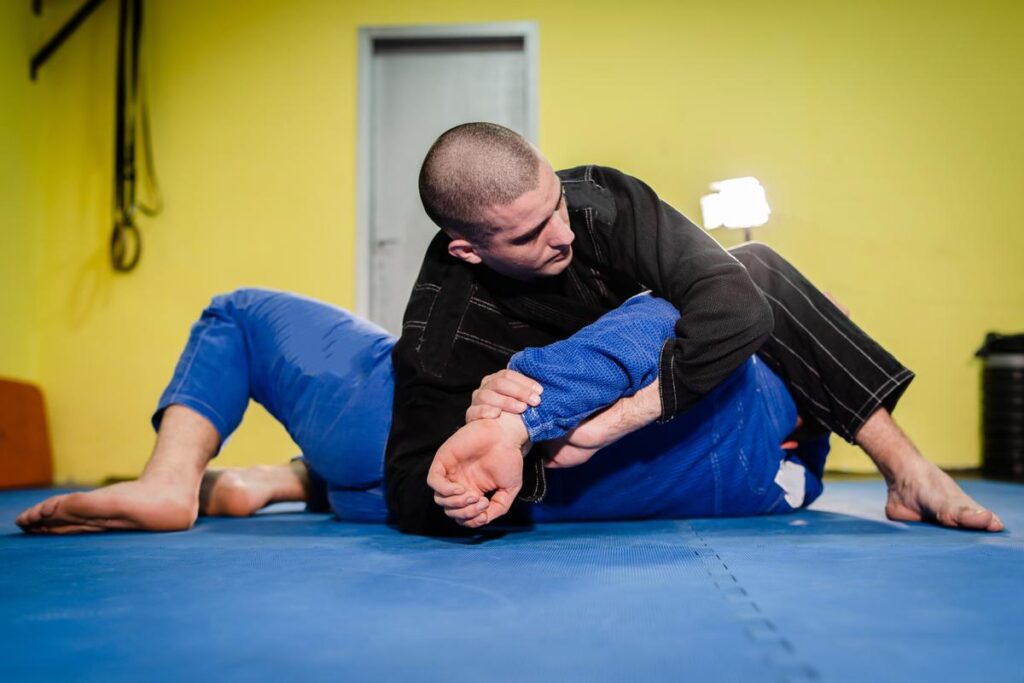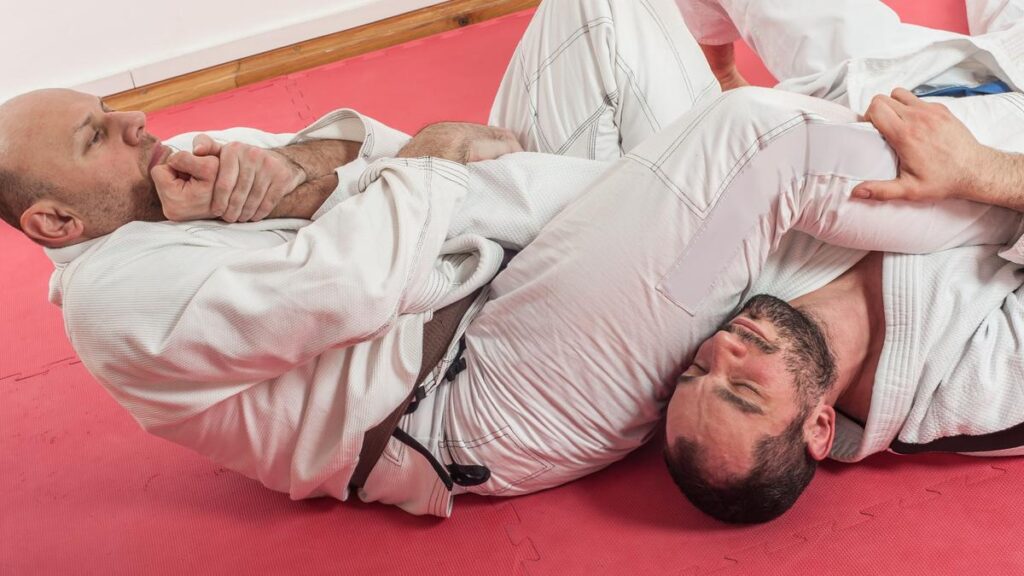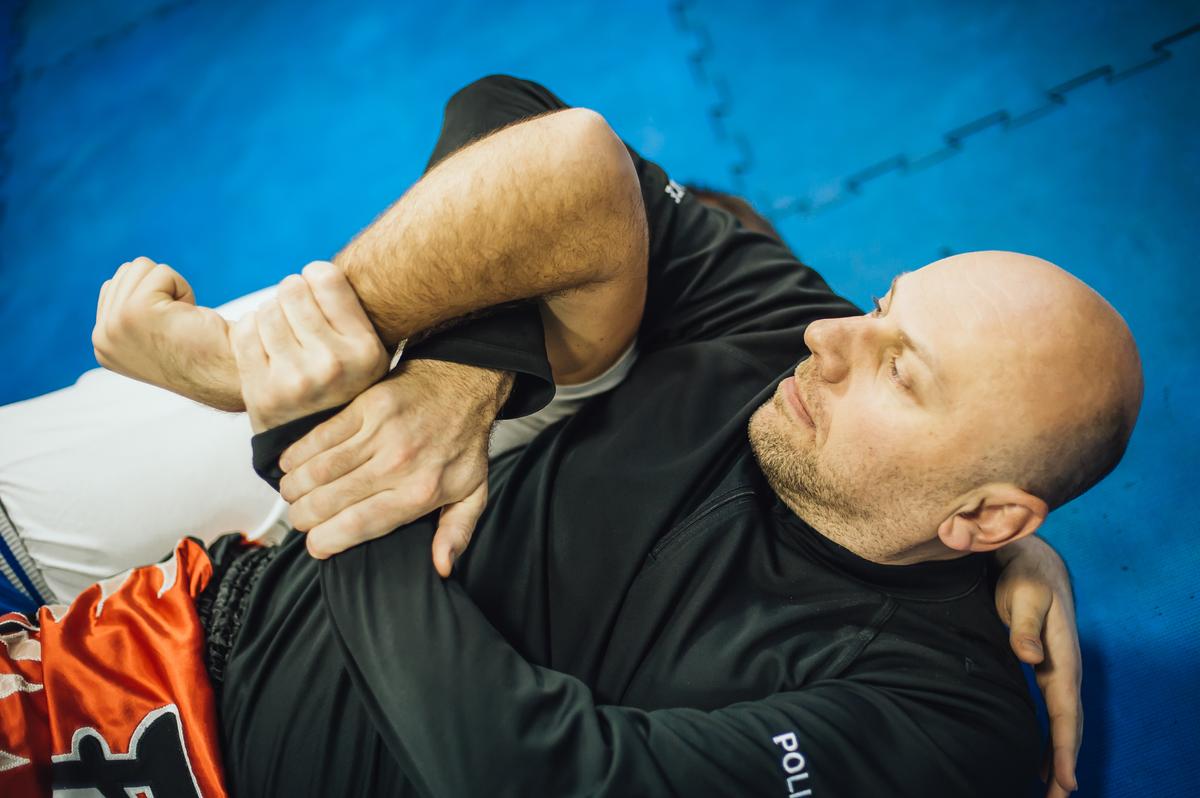The Kimura lock, also known as a double wrist lock, is one of the most effective submission techniques used in Brazilian Jiu-Jitsu. In this article we will discuss What Is Kimura Lock Is In Jiu Jitsu
This powerful shoulder lock was named after the Japanese judoka Masahiko Kimura, who used it to famously defeat Helio Gracie, the founder of Gracie Jiu-Jitsu, in a historic mixed martial arts fight in 1951.
The Kimura lock works by controlling an opponent’s wrist and elbow joint, and then applying pressure to create an extreme rotation of the shoulder.
Executed correctly, it allows a Jiu-Jitsu practitioner to either force their opponent to tap out, or risk serious injury to the shoulder joint.
While other grappling styles make use of similar double wrist lock techniques, the Kimura lock is particularly prevalent in Brazilian Jiu-Jitsu due to the art’s focus on submission holds and ground fighting. It is considered one of the highest percentage submission techniques in the sport.
To properly set up a Kimura lock, a BJJ practitioner will first grip their opponent’s right wrist with their left hand. With their right hand, they will firmly control the opponent’s right elbow. The next step is to step the right leg over the opponent’s body, so that the Jiu-Jitsu artist is perpendicular to the opponent.
This body positioning is important as it allows the practitioner to create optimal leverage and angle to hyperextend the shoulder joint. Once in position, the opponent’s arm can be raised up and bent behind their head, while maintaining control of the wrist and elbow.
Pressure can then be applied by pulling the wrist towards the Jiu-Jitsu artist’s own body, while pushing and isolating the elbow away.
This puts an extreme amount of rotational force through the shoulder joint. As the pressure increases, it will eventually cause the opponent to either tap out in submission, or risk severe damage to their shoulder such as tearing of ligaments or tendons.
The Kimura lock can be applied effectively from several different positions and scenarios. It is most commonly executed from side control or north-south position, when the opponent’s arm is exposed.
However, it can also be applied from the guard, as a counter to an opponent grabbing the uniform collar for example.
When performed correctly with proper control, the Kimura lock allows a Jiu-Jitsu fighter to end matches quickly and efficiently.
No doubt that is why Masahiko Kimura chose to use this technique against Helio Gracie in their historic fight in Brazil so many years ago.
The Kimura lock has truly stood the test of time as one of the most feared and fundamental submission techniques in Brazilian Jiu-Jitsu. Any student of the art would be wise to learn this shoulder lock and all its variations, in order to gain a potent weapon for their ground fighting arsenal.
You also must know about What Is Guard Position In BJJ, How Do BJJ Tournaments Work?, How To Improve Half Guard Game BJJ and now lets on our today called “What Is Kimura Lock Is In Jiu Jitsu”
How to Execute the Kimura Lock

To properly execute a Kimura lock, a BJJ practitioner will first grip their opponent’s right wrist with their left hand. The grip should be tight, with the thumb pressed firmly into the back of the opponent’s hand.
With their right hand, the BJJ artist will firmly control the opponent’s right elbow. The elbow should be grabbed above the joint, allowing maximum control.
The next step is to step the right leg over the opponent’s body, so that the Jiu-Jitsu artist is perpendicular to the opponent. This body positioning is important as it allows the practitioner to create optimal leverage and angle to hyperextend the shoulder joint.
Once in position, the opponent’s arm can be raised up and bent behind their head, while maintaining control of the wrist and elbow. It is important to keep the opponent’s elbow positioned tight against the hip during this motion, to increase control and prevent escape.
Applying Pressure for the Submission
Pressure can then be applied by pulling the wrist towards the Jiu-Jitsu artist’s own hip, while isolating and pushing the elbow away. This puts an extreme amount of rotational force through the shoulder joint. As the pressure increases, it will eventually cause the opponent to either tap out in submission, or risk severe damage to their shoulder such as tearing of ligaments or tendons.
It is important to apply the Kimura lock submission slowly, keeping control of the wrist and elbow at all times. The shoulder can be damaged if too much force is applied too quickly. A properly executed Kimura will have the opponent tapping out long before injury occurs.
Setups and Positions for the Kimura
The Kimura lock can be applied effectively from several different positions and scenarios. It is most commonly executed from side control or north-south position, when the opponent’s arm is exposed. However, it can also be applied from the guard, as a counter to an opponent grabbing the uniform collar for example.
Other common set ups include chaining the Kimura off of a failed armbar attempt, or switching grips to attack the Kimura when the opponent is defending the armbar. This grip change surprise often catches opponents off guard. The Kimura can also be used as a sweep or reversal against opponents in the turtle position.
Defending Against the Kimura Lock
To defend against the Kimura lock, opponents must be mindful not to leave their arms over extended or isolated from their body.

Keeping the elbow tight against the body makes it much harder to secure the arm behind the back. Opponents can also push against the Jiu-Jitsu artist’s hips to create space, and rotate the arm against the direction of the lock to relieve shoulder pressure.
If caught in a Kimura lock, acting quickly is key. Opponents can try to roll in the same direction as the lock to force the Jiu-Jitsu artist to lose control of the wrist and elbow.
Other escape methods include posturing up to reduce leverage, or attempting to pry apart the grip on the wrist.
Executing the Kimura Lock from Side Control
The most basic application of the Kimura is from side control top position. From here, the BJJ artist traps their opponent’s near side arm close to their own hip. Gripping the wrist tightly with the opposite hand, the practitioner can then grab hold of the elbow and begin to isolate the shoulder joint.
By hugging the arm tight to their torso and hip, the BJJ artist can raise the opponent’s elbow up and behind their head. This angle is perfect for rotating the shoulder joint. The submissive tap out comes from pressure applied by pulling the wrist in and pushing the elbow out.
Attacking with the Kimura from North-South
The north-south position offers another prime opportunity to attack the Kimura lock. Here, the BJJ artist feeds their opponent’s near side arm through their armpit and legs.
Keeping the arm isolated and hugged close to their own shoulder, the practitioner can then grab the wrist and finish in similar fashion to the side control Kimura.
The north-south Kimura utilizes gravity and downward pressure to keep the arm controlled. It also allows the BJJ artist to step over the head if more leverage is needed to finish the shoulder lock.
Kimura Lock Applications from the Guard
While not as common, the Kimura can also be very effective when applied from the closed guard. If the opponent reaches for the lapel or collar grip with one arm, the BJJ practitioner can swim their arm inside for the Kimura grip.
Using their legs and hips to break their opponent’s posture, the Kimura can be finished by isolating the shoulder joint and disrupting their base. This guard Kimura functions well as both an attack and a sweep.
Chaining the Kimura with Other Submissions
One of the big advantages of the Kimura is that it flows well into other submission attempts. For example, when an armbar attempt fails, switching to the Kimura grip can often yield better results. The change of angle attacks the shoulder from a different direction.
The Kimura lock can also be chained and set up off of chokes such as the north-south choke, side choke from mount, and even rear naked choke attempts.
If finished correctly, opponents will be so concerned about defending the choke that they allow their arm to be isolated for the Kimura.
Common Defenses Against the Kimura
To defend against the Kimura, opponents should look to keep their elbow tight to their torso, not allowing it to be isolated.
If caught in a Kimura, they can posture up or roll in the direction of the lock to alleviate pressure on the shoulder joint. Quickly breaking the grips is key to escaping.
While a very potent technique, the Kimura does have some vulnerabilities opponents can exploit. BJJ artists should be mindful not to force the lock too quickly at the risk of injury. Maintaining control of the wrist and elbow is critical for both safety and efficiency.
Defense and Escapes
Keeping the Elbow Tight
The first key to defending the Kimura is preventing the opponent from isolating your elbow and arm.
Keeping the elbow tight against your torso limits the shoulder rotation needed to finish the lock. Try bending the elbow at a 90 degree angle and pinning it to your side. Grip your own gi lapel if needed. This frames the elbow against your body.
From here, opponents can also turn their thumb up to the ceiling to further alleviate pressure. This counter-rotates the shoulder against the direction of the Kimura. Keeping the hips low and heavy, as opposed to high and light, also helps prevent the arm from being controlled.
Creating Space by Pushing on the Hips
If caught in a Kimura, opponents can attempt to create space by pushing or posting on the BJJ artist’s hips. This makes it harder for them to isolate the arm and limits their ability to step over for leverage. Framing against the hips can also allow opponents to shrimp their hips out, rotating their torso away from the submission.
Turning Into the Kimura Lock
Turning and rolling in the same direction as the Kimura lock can also help relieve pressure on the shoulder joint. This forces the BJJ artist to loosen their control of the wrist and elbow as their own arm gets framed across their body.
It also changes the angle, making it more difficult for the BJJ practitioner to fully extend the arm behind the head. Quickly turning into the Kimura takes away much of its leverage.
Stripping the Grips
If caught early enough, opponents may still have time to strip the grips before the lock is set too deep. This may require acting fast to pry apart the fingers before control is established. Peeling individual fingers back or grabbing a finger and pulling sharply can help break the opponent’s grip on your wrist.
Keep in mind grip fighting skills should be used early in the encounter. Once the Kimura grip is set, it becomes much harder to strip the fingers. At that point, focus should shift to the other escape methods already discussed.
Avoiding Common Mistakes
When trying to escape the Kimura, opponents should avoid straightening the arm past the point of safety. This will only increase the shoulder torque and risk of injury. Never forget to tap once the arm is fully extended.
Opponents should also avoid simply holding onto their own gi material if the grips are already set. This leaves the arm still isolated and controlled for the lock. Proper escapes require urgent action to disrupt the mechanic.
Applying Pressure Slowly to Force the Tap
The key to securing a tap out from the Kimura lock is applying pressure slowly, not quickly yanking or cranking the arm.
Once the grip and control positions are secured, pressure should be built gradually. Pull the wrist in towards the hips while keeping the elbow isolated and pushed away to slowly increase shoulder rotation.
As the shoulder reaches its maximal range, the pressure on tendons and ligaments will eventually force a submit.
By modulating pressure, BJJ artists can allow their opponent time to recognize the submission is imminent and tap out. Applying the lock gradually helps preserve the well-being of both athletes.
Knowing the Limitations
It’s important for BJJ practitioners to understand both the power and limitations of the Kimura lock.
When pressure is applied too fast, or the arm cranked past the safe point of rotation, shoulder damage can occur. This may include torn labrums, dislocated joints, damaged ligaments and tendons.
While it can end matches decisively, the Kimura should never be used with the intent to injury. Applying it in a controlled manner allows training partners time to tap before approaching dangerous extensions. Forcing a Kimura beyond normal ranges will only cause harm.
Maintaining Control Until the Tap
Once pressure begins to increase, it’s critical that control of the wrist and elbow are maintained until the opponent taps out.
Releasing pressure or control too early gives them a chance to escape and spin out of danger. However, holding the Kimura a moment too long can cause damage.
BJJ artists must remain deeply focused on their training partner, ready to release immediately at the first sign of a tap. Keeping constant isolation until the exact moment of submission keeps finish safe, efficient and definitive.
Considering the Training Partner’s Health
When deciding how to finish any submission, BJJ practitioners must take into account factors like their partner’s age, health history and skill level.
Special care should be taken when applying techniques like the Kimura to training partners who are elderly, previously injured, or newer students.
What may be an efficient finish for a young competitive athlete may cause injury to a 60 year old hobbyist. Adapting pressure and speed accordingly displays respect and care for the training partner.
Wrapping Up On “What Is Kimura Lock Is In Jiu Jitsu?“
In closing of What Is Kimura Lock Is In Jiu Jitsu?, the Kimura lock remains one of the most fundamental and effective submissions within Brazilian Jiu-Jitsu.
Since Kimura lock is in Jiu Jitsu was first introduced many decades ago, it has become a staple technique known by every BJJ practitioner. By controlling the wrist, elbow, and shoulder joint, the Kimura allows jiu-jitsu fighters to force opponents to submit or risk injury.
However, it must be applied with care and precision in order to safely achieve submission without causing harm.
When utilized properly, the Kimura lock exemplifies the core philosophies of jiu-jitsu through its balance of effectiveness and preservation of health and well-being.
For any student of BJJ, learning both the technical execution and respectful application of the Kimura should be considered absolutely essential.

1 thought on “What Is Kimura Lock Is In Jiu Jitsu?”
Comments are closed.